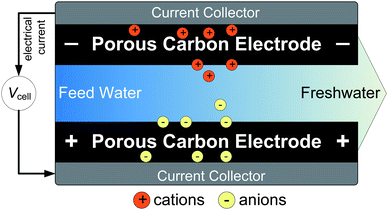There are many ways to desalinate sea or brackish water. The aim is to separate the salts from the water in any way possible. One example is that one can evaporate the water, like the sun does with our ocean water, to then condense it (like rain). Even this process can be done by both heating and decompression, so two ways. There are many others.

principle of charge based water purification done by ionicsolutions
The most popular we see in use at the moment however seems to be selected for its economic value, meaing it uses a lot of energy. It is called Reverse Osmosis. What it boils down to (no pun sorry) is that water is pressed through a membrane with holes to sall for Sodium or Cloride (The two constituents of common seasalt), probably a lot of other molecules and atoms are to big for the filter. This is against the pressure of osmosis, which dictates that water tries to dilude a salty solution, so will by itself move from the fresh to the salty side.

Winds increasing capacity makes it a better fit for desalination (source).
Reverse Osmosis is chosen for a number of reasons, mainly (we think) because it is difficult and requires constant care and spare parts etc. Not that a RO filter cant function without hitch over longer periods, but one needs the specialize filters, while with freeze desalination or flash evaporation there are no unique parts.
A small-scale (mechanical) wind-powered RO system was constructed and tested by Robinson et al. (1992). Freshwater production by their system was only 0.5 to 1.0 cubic meters per day, which is the estimated volume needed by a typical remote community in Australia. (source)
We can’t keep playing this economic game of owning some special patent of technique or product and then selling it around the world. Even if the price is low, it is not secure to have such dependencies. Also, the energy requirements of RO desalination which in the past made people happy (as a coal or nuclear plant had to be build next to the desalination plant) are just to big. Solar RO with solar panels, Wind RO with wind hydraulic pressure or gravity (pulling water from a great hight) are still stupid ideas.
The system presented here comprises a 2.2 kW wind turbine generator powering a variable-flow Reverse osmosis (RO) desalination unit. (source)
We need so much fresh water, either from seawater, polluted ground water or brackish water soon, that RO around the world would only increase the problems. We need to use alternatives, but for these alternatives there is one problem : They are cheap.
5 wind turbines of type Bonus 2 MW. It was found that wind energy can successfully power a SWRO desalination plant in the case study region. (source)
The domination of RO is about to be smashed however. The new technology, called ionic desalination is not really new. We wrote about it years ago, and it has been in use for much longer. It uses the electric proterties of ions to separate them from water.
Energy for desalination :
- RO 5 Wh/L
- Electro dialysis 20 Wh/l
- Micro/Nanofluidic Desalination Method 3.5 Wh/L (source)
Salt, NaCl dissolves in water into Na+ and CL- ions. These will follow an electric gradient if it is applied. One way to separate them from water is to apply a current to the water, and the Na- will move to the negative pole, the Cl- to the positive (to form Na? and Cl2). This happens in primitve water splitters, and as Cl2 is toxic, they can be unhealthy.

One way to use this is to draw the Na and Cl through a membrane to another space they can not escape from. This is what was done in the Salttech concept, which was interesting because it created the potential to draw the ions out by using the same ions in an osmotic battery (Where Na+ and Cl-) create a potential by leaving a solution to two separate other solutions due to osmotic pressure (its complicated). This works, but one can do better.
“we report a process for converting sea water (salinity ~500 mM or ~30,000 mg l−1) to fresh water (salinity <10 mM or <600 mg l−1) in which a continuous stream of sea water is divided into desalted and concentrated streams by ion concentration polarization, a phenomenon that occurs when an ion current is passed through ion-selective membranes. ” (source)
Just like ultracapacitors are batteries that never really charge, but only draw ions to their electrodes, so the new type of ionic desalination doesn’t try to remove ions from the water, only to bind them, to wash them into brine later. This type of membrane is actually easy to make, low cost, low pressure. The basic materials can be carbon (activated) and Titanium Oxide (if you want to use sunlight to photo activate the carbon) or graphene (single atom thickness carbon sheets usually made from graphite).

The material to remove ions can be as simple as activated carbon (source)
New graphene based filters are even better, they can be turned into a charged filter that keeps 100% the salts out while not requiring large pressure for water to get through. The charge is also not consumed, in the sense that the charge itself does not move or flow, it only repels ions which takes energy from the ions, not electricity.
“The energy that’s required and the pressure that’s required to filter salt is approximately 100 times less” (source)
By intercalating monolayer titania (TO) nanosheets into graphene oxide (GO) laminates with mild ultraviolet (UV) reduction, the as-prepared RGO/TO hybrid membranes exhibit excellent water desalination performance (source)
Carbon Tio for removal of pharmaceuticals
Taliking about capacitative desalination tech improvement. Set to beat RO in cost soon. from LLEL. Applications suggested are fracking waste water treatment just like Saltworks is doing, possibly paying for delaying it’s entrance as competitor to RO.